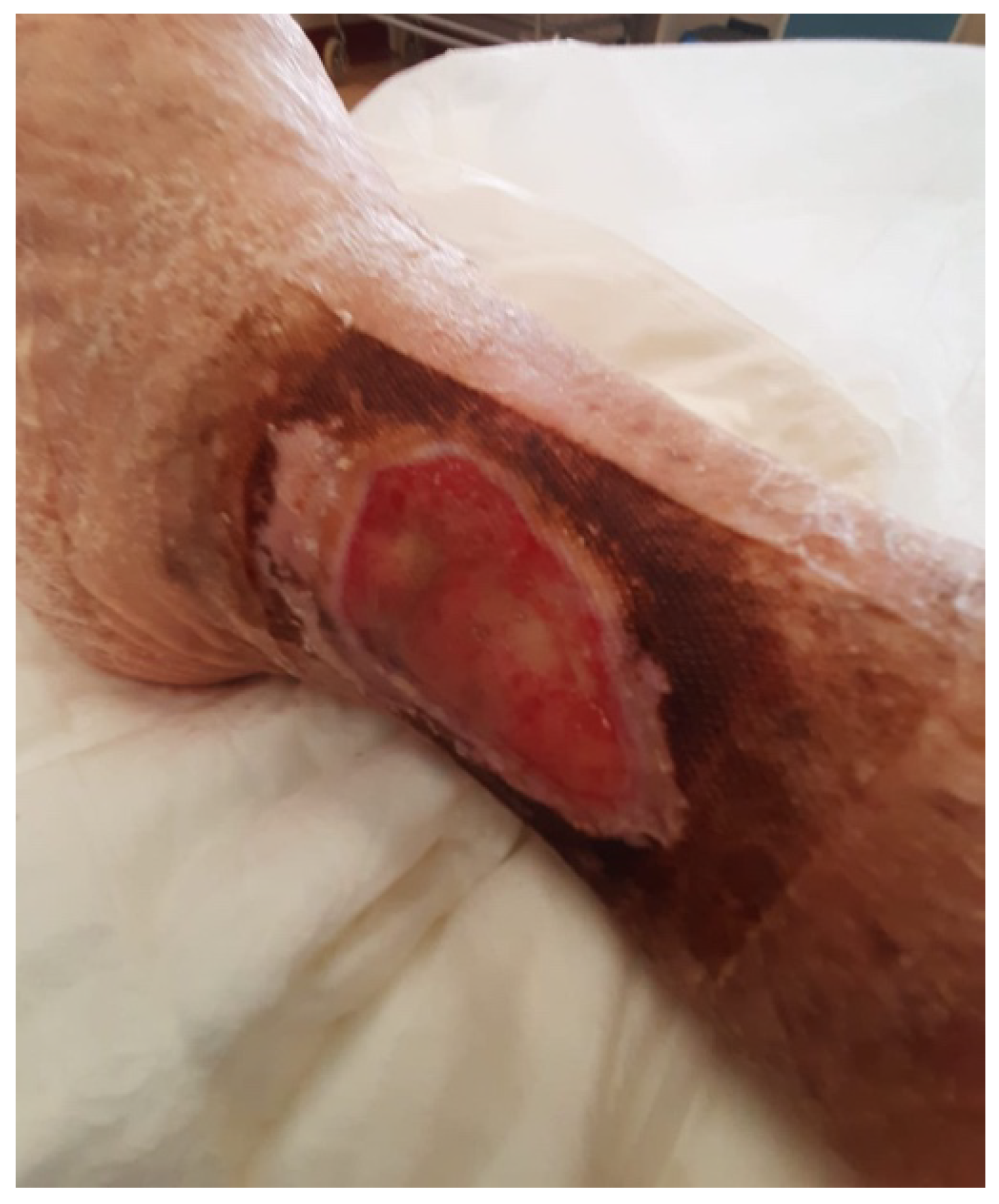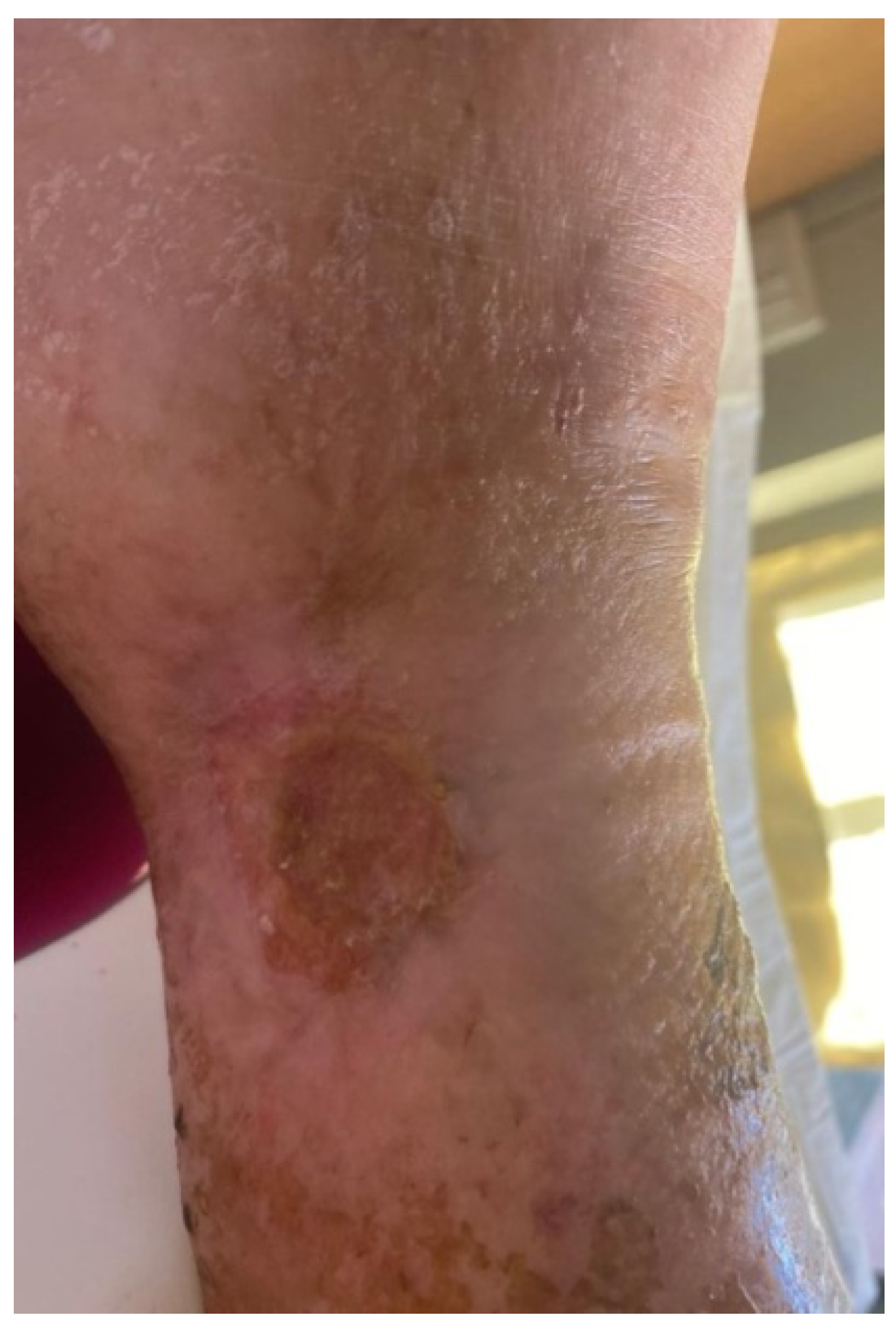High-Intensity, Low-Frequency Pulsed Electromagnetic Field as an Odd Treatment in a Patient with Mixed Foot Ulcer: A Case Report
Abstract
:1. Introduction
2. Case Presentation
Diamagnetic Therapy Protocol
3. Results
4. Discussion and Conclusions
Author Contributions
Funding
Institutional Review Board Statement
Informed Consent Statement
Acknowledgments
Conflicts of Interest
References
- Schneider, C.; Stratman, S.; Kirsner, R.S. Lower Extremity Ulcers. Med Clin. N. Am. 2021, 105, 663–679. [Google Scholar] [CrossRef] [PubMed]
- Kirsner, R.; Vivas, A. Lower-extremity ulcers: Diagnosis and management. Br. J. Dermatol. 2015, 173, 379–390. [Google Scholar] [CrossRef]
- Powers, J.G.; Higham, C.; Broussard, K.; Phillips, T. Wound healing and treating wounds. J. Am. Acad. Dermatol. 2016, 74, 607–625. [Google Scholar] [CrossRef]
- Harries, R.L.; Bosanquet, D.C.; Harding, K.G. Wound bed preparation: TIME for an update. Int. Wound J. 2016, 13 (Suppl. 3), 8–14. [Google Scholar] [CrossRef] [PubMed]
- Gallelli, G.; Cione, E.; Serra, R.; Leo, A.; Citraro, R.; Matricardi, P.; Di Meo, C.; Bisceglia, F.; Caroleo, M.C.; Basile, S.; et al. Nano-hydrogel embedded with quercetin and oleic acid as a new formulation in the treatment of diabetic foot ulcer: A pilot study. Int. Wound J. 2019, 17, 485–490. [Google Scholar] [CrossRef]
- Romano, F.; Paolino, F.M.; Rizzo, B.A.; Russo, A.; Southworth, S.; Serra, R.; Gallelli, L. The use of growth factors, CD34+cells and fibrin for the management of chronic venous ulcers. Int. Wound J. 2015, 13, 1011–1013. [Google Scholar] [CrossRef]
- Serra, R.; Gallelli, L.; Conti, A.; De Caridi, G.; Mafalda, M.M.; Spinelli, F.; Buffone, G.; Amato, B.; Ceglia, S.; Spaziano, G.; et al. The effects of sulodexide on both clinical and molecular parameters in patients with mixed arterial and venous ulcers of lower limbs. Drug Des. Dev. Ther. 2014, 8, 519–527. [Google Scholar] [CrossRef] [PubMed] [Green Version]
- Jones, R.E.; Foster, D.S.; Longaker, M.T. Management of Chronic Wounds—2018. JAMA: J. Am. Med Assoc. 2018, 320, 1481–1482. [Google Scholar] [CrossRef] [PubMed]
- Markov, M.S. Magnetic Field Therapy: A Review. Electromagn. Biol. Med. 2007, 26, 1–23. [Google Scholar] [CrossRef]
- Jiao, M.; Yin, H.; Hu, J.; Xu, W.; Zhang, X.; Zhang, P. Effects of Low-Frequency Pulsed Electromagnetic Fields on High-Altitude Stress Ulcer Healing in Rats. BioMed Res. Int. 2019, 2019, 6354054–8. [Google Scholar] [CrossRef]
- Ross, C.L. The use of electric, magnetic, and electromagnetic field for directed cell migration and adhesion in regenerative medicine. Biotechnol. Prog. 2017, 33, 5–16. [Google Scholar] [CrossRef]
- Albuquerque, W.; Costa, R.M.P.B.; de Salazar e Fernandes, T.; Porto, A.L.F. Evidences of the static magnetic field influence on cellular systems. Prog. Biophys. Mol. Biol. 2016, 121, 16–28. [Google Scholar] [CrossRef] [PubMed]
- Saliev, T.; Mustapova, Z.; Kulsharova, G.; Bulanin, D.; Mikhalovsky, S. Therapeutic potential of electromagnetic fields for tissue engineering and wound healing. Cell Prolif. 2014, 47, 485–493. [Google Scholar] [CrossRef] [PubMed] [Green Version]
- Costin, G.-E.; Birlea, S.A.; Norris, D.A. Trends in wound repair: Cellular and molecular basis of regenerative therapy using electromagnetic fields. Curr. Mol. Med. 2012, 12, 14–26. [Google Scholar] [CrossRef] [PubMed]
- Premi, E.; Benussi, A.; La Gatta, A.; Visconti, S.; Costa, A.; Gilberti, N.; Cantoni, V.; Padovani, A.; Borroni, B.; Magoni, M. Modulation of long-term potentiation-like cortical plasticity in the healthy brain with low frequency-pulsed electromagnetic fields. BMC Neurosci. 2018, 19, 34. [Google Scholar] [CrossRef]
- Izzo, M.; Napolitano, L.; Coscia, V.; La Gatta, A.; Mariani, F.; Gasbarro, V. The role of Diamagnetic Pump (CTU mega 18) in the physical treatment of Limbs Lymphoedema. A Clinical study. Eur. J. Lymphol. 2010, 21. [Google Scholar]
- Apolone, G.; Mosconi, P. The Italian SF-36 Health Survey: Translation, Validation and Norming. J. Clin. Epidemiol. 1998, 51, 1025–1036. [Google Scholar] [CrossRef]
- Hedayati, N.; Carson, J.G.; Chi, Y.-W.; Link, D. Management of mixed arterial venous lower extremity ulceration: A review. Vasc. Med. 2015, 20, 479–486. [Google Scholar] [CrossRef] [PubMed]
- Mallet, L.; Spinewine, A.; Huang, A. The challenge of managing drug interactions in elderly people. Lancet 2007, 370, 185–191. [Google Scholar] [CrossRef]
- Gallelli, L.; Siniscalchi, A.; Palleria, C.; Mumoli, L.; Staltari, O.; Squillace, A.; Maida, F.; Russo, E.; Gratteri, S.; De Sarro, G.; et al. Adverse Drug Reactions Related to Drug Administration in Hospitalized Patients. Curr. Drug Saf. 2017, 12, 171–177. [Google Scholar] [CrossRef]
- O’Meara, S.; Cullum, N.; Nelson, E.A.; Dumville, J.C. Compression for venous leg ulcers. Cochrane Database Syst. Rev. 2012, 2012, CD000265. [Google Scholar] [CrossRef] [PubMed] [Green Version]
- Mosti, G.; Iabichella, M.L.; Partsch, H. Compression therapy in mixed ulcers increases venous output and arterial perfusion. J. Vasc. Surg. 2012, 55, 122–128. [Google Scholar] [CrossRef] [PubMed] [Green Version]
- Kranke, P.; Bennett, M.H.; James, M.M.-S.; Schnabel, A.; Debus, S.E.; Weibel, S. Hyperbaric oxygen therapy for chronic wounds. Cochrane Database Syst. Rev. 2015, 2015, CD004123. [Google Scholar] [CrossRef]
- Mert, T.; Yaman, S. Pro-inflammatory or anti-inflammatory effects of pulsed magnetic field treatments in rats with experimental acute inflammation. Environ. Sci. Pollut. Res. 2020, 27, 31543–31554. [Google Scholar] [CrossRef]
- Purnell, M.C.; Skrinjar, T.J. The dielectrophoretic disassociation of chloride ions and the influence on diamagnetic anisotropy in cell membranes. Discov. Med. 2016, 22, 257–273. [Google Scholar]
- Smith, T.L.; Wong-Gibbons, D.; Maultsby, J. Microcirculatory effects of pulsed electromagnetic fields. J. Orthop. Res. 2004, 22, 80–84. [Google Scholar] [CrossRef]
- Bragin, D.E.; Statom, G.L.; Hagberg, S.; Nemoto, E.M. Increases in microvascular perfusion and tissue oxygenation via pulsed electromagnetic fields in the healthy rat brain. J. Neurosurg. 2015, 122, 1239–1247. [Google Scholar] [CrossRef] [Green Version]
- Callaghan, M.J.; Chang, E.I.; Seiser, N.; Aarabi, S.; Ghali, S.; Kinnucan, E.R.; Simon, B.J.; Gurtner, G.C. Pulsed Electromagnetic Fields Accelerate Normal and Diabetic Wound Healing by Increasing Endogenous FGF-2 Release. Plast. Reconstr. Surg. 2008, 121, 130–141. [Google Scholar] [CrossRef]
- Lee, R.C.; Canaday, D.J.; Doong, H. A Review of the Biophysical Basis for the Clinical Application of Electric Fields in Soft-Tissue Repair. J. Burn. Care Rehabil. 1993, 14, 319–335. [Google Scholar] [CrossRef]
- Aziz, Z.; Cullum, N. Electromagnetic therapy for treating venous leg ulcers. Cochrane Database Syst. Rev. 2015, 2015, CD002933. [Google Scholar] [CrossRef] [PubMed] [Green Version]
- Markoll, R.; Ferreira, D.M.D.S.; Toohil, T.K. Pulsed Signal Therapy®: An overview. APLAR J. Rheumatol. 2003, 6, 89–100. [Google Scholar] [CrossRef]
- Gill, S.E.; Parks, W.C. Metalloproteinases and their inhibitors: Regulators of wound healing. Int. J. Biochem. Cell Biol. 2008, 40, 1334–1347. [Google Scholar] [CrossRef] [Green Version]
- Gordon, G.A. Designed electromagnetic pulsed therapy: Clinical applications. J. Cell. Physiol. 2007, 212, 579–582. [Google Scholar] [CrossRef]
- Dunnill, C.; Patton, T.; Brennan, J.; Barrett, J.; Dryden, M.; Cooke, J.; Leaper, D.; Georgopoulos, N.T. Reactive oxygen species (ROS) and wound healing: The functional role of ROS and emerging ROS-modulating technologies for augmentation of the healing process. Int. Wound J. 2017, 14, 89–96. [Google Scholar] [CrossRef]
- Strauch, B.; Patel, M.K.; Navarro, J.A.; Berdichevsky, M.; Yu, H.-L.; Pilla, A.A. Pulsed Magnetic Fields Accelerate Cutaneous Wound Healing in Rats. Plast. Reconstr. Surg. 2007, 120, 425–430. [Google Scholar] [CrossRef] [PubMed]
- Detlavs, I.; Dombrovska, L.; Turauska, A.; Shkirmante, B.; Slutskii, L. Experimental study of the effects of radiofrequency electromagnetic fields on animals with soft tissue wounds. Sci. Total Environ. 1996, 180, 35–42. [Google Scholar] [CrossRef]
- Ieran, M.; Zaffuto, S.; Bagnacani, M.; Annovi, M.; Moratti, A.; Cadossi, R. Effect of low frequency pulsing electromagnetic fields on skin ulcers of venous origin in humans: A double-blind study. J. Orthop. Res. 1990, 8, 276–282. [Google Scholar] [CrossRef]
- Stiller, M.; Pak, G.H.; Shupack, J.; Thaler, S.; Kenny, C.; Jondreau, L. A portable pulsed electromagnetic field (PEMF) device to enhance healing of recalcitrant venous ulcers: A double-blind, placebo-controlled clinical trial. Br. J. Dermatol. 1992, 127, 147–154. [Google Scholar] [CrossRef]
- Kenkre, J.; Hobbs, R.; Carter, Y.; Holder, R.; Holmes, E. A randomized controlled trial of electromagnetic therapy in the primary care management of venous leg ulceration. Fam. Pr. 1996, 13, 236–241. [Google Scholar] [CrossRef] [PubMed]
- Pasek, J.; Cieślar, G.; Sieroń, A. Combined therapy in the treatment of mixed etiology leg ulcer—Case report. Ther. Clin. Risk Manag. 2018, ume 14, 1915–1921. [Google Scholar] [CrossRef] [Green Version]
- Lv, H.; Liu, J.; Zhen, C.; Wang, Y.; Wei, Y.; Ren, W.; Shang, P. Magnetic fields as a potential therapy for diabetic wounds based on animal experiments and clinical trials. Cell Prolif. 2021, 54, e12982. [Google Scholar] [CrossRef] [PubMed]
- Zborowski, M.; Midura, R.J.; Wolfman, A.; Patterson, T.; Ibiwoye, M.; Sakai, Y.; Grabiner, M. Magnetic field visualization in applications to pulsed electromagnetic field stimulation of tissues. Ann. Biomed. Eng. 2003, 31, 195–206. [Google Scholar] [CrossRef]
- Raghu, P.K.; Bansal, K.K.; Thakor, P.; Bhavana, V.; Madan, J.; Rosenholm, J.M.; Mehra, N.K. Evolution of Nanotechnology in Delivering Drugs to Eyes, Skin and Wounds via Topical Route. Pharmaceuticals 2020, 13, 167. [Google Scholar] [CrossRef]
- Murthy, S.N.; Sammeta, S.M.; Bowers, C. Magnetophoresis for enhancing transdermal drug delivery: Mechanistic studies and patch design. J. Control. Release 2010, 148, 197–203. [Google Scholar] [CrossRef] [PubMed] [Green Version]


| Age, years | 94 |
| Sex | Female |
| Weight, Kg | 75 |
| Height, cm | 167 |
| BMI | 26.9 |
| Smoke | Ceased 20 years ago |
| Previous surgery | Right knee’s arthroprotesis |
| Drug allergy | Diclofenac (referred) |
| Comorbidities and pharmacological daily treatments | |
| Asthmatic bronchitis | Salmeterol 50 mcg plus fluticasone 100 mcg bid |
| Tiotropium 18 mcg qd | |
| Oxygenotherapy 3 lt qd | |
| Cardiovascular and cerebrovascular disease | Acetylsalicylic acid 100 mg qd |
| Clopidogrel 75 mg qd | |
| Losartan 50 mg plus hydrochlorothiazide 12.5 mg qd | |
| Gastroesophageal reflux disease | Pantoprazole 20 mg qd |
| Hyperuricaemia | Allopurinol 300 mg qd |
| Rheumatoid arthritis (not documented) | Dexamethasone 4 mg qd |
Publisher’s Note: MDPI stays neutral with regard to jurisdictional claims in published maps and institutional affiliations. |
© 2022 by the authors. Licensee MDPI, Basel, Switzerland. This article is an open access article distributed under the terms and conditions of the Creative Commons Attribution (CC BY) license (https://creativecommons.org/licenses/by/4.0/).
Share and Cite
Roberti, R.; Marcianò, G.; Casarella, A.; Rania, V.; Palleria, C.; Muraca, L.; Citraro, R.; De Sarro, G.; Serra, R.; Romeo, P.; et al. High-Intensity, Low-Frequency Pulsed Electromagnetic Field as an Odd Treatment in a Patient with Mixed Foot Ulcer: A Case Report. Reports 2022, 5, 3. https://doi.org/10.3390/reports5010003
Roberti R, Marcianò G, Casarella A, Rania V, Palleria C, Muraca L, Citraro R, De Sarro G, Serra R, Romeo P, et al. High-Intensity, Low-Frequency Pulsed Electromagnetic Field as an Odd Treatment in a Patient with Mixed Foot Ulcer: A Case Report. Reports. 2022; 5(1):3. https://doi.org/10.3390/reports5010003
Chicago/Turabian StyleRoberti, Roberta, Gianmarco Marcianò, Alessandro Casarella, Vincenzo Rania, Caterina Palleria, Lucia Muraca, Rita Citraro, Giovambattista De Sarro, Raffaele Serra, Pietro Romeo, and et al. 2022. "High-Intensity, Low-Frequency Pulsed Electromagnetic Field as an Odd Treatment in a Patient with Mixed Foot Ulcer: A Case Report" Reports 5, no. 1: 3. https://doi.org/10.3390/reports5010003
APA StyleRoberti, R., Marcianò, G., Casarella, A., Rania, V., Palleria, C., Muraca, L., Citraro, R., De Sarro, G., Serra, R., Romeo, P., & Gallelli, L. (2022). High-Intensity, Low-Frequency Pulsed Electromagnetic Field as an Odd Treatment in a Patient with Mixed Foot Ulcer: A Case Report. Reports, 5(1), 3. https://doi.org/10.3390/reports5010003








